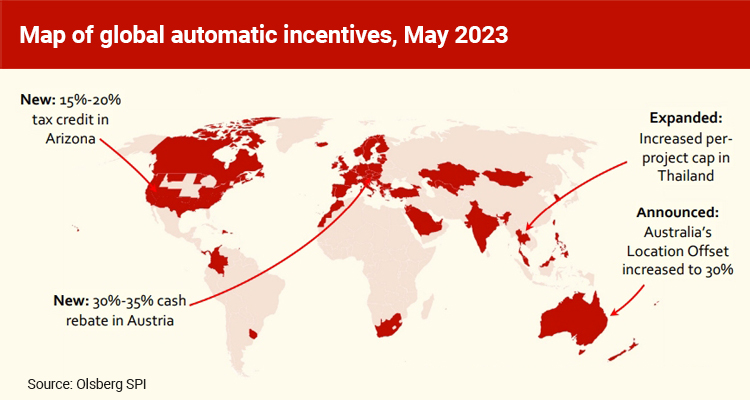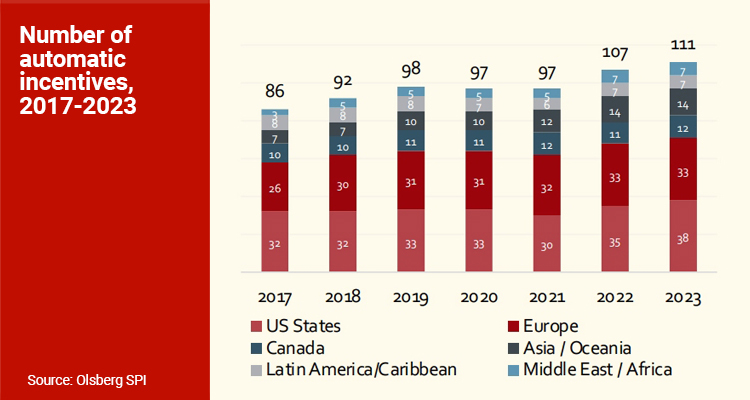Audiovisual co-productions and the incentives to carry them out continue to play a valuable role in the global content industry. With a general rate of around 25-30% of eligible spending (although higher rates and other benefits are offered), they can provide developers with the cornerstone of a financing plan for their project and an instrumental role in locating funds. the productions.
By their nature, incentives allow producers to reduce costs and, consequently, risks. Locations that offer incentives are also positioned as «film friendly» and thus offer other advantages such as the ease of obtaining filming permits, temporary importation of baggage, and other fundamental conditions for a successful production.
That is why many countries and regions have been implementing incentive programs to be increasingly competitive in attracting investment for audiovisual productions. In this report, Prensario reviews some of the incentive programs in force in the countries of the CEE region.

Czech Republic
Being a very cinematographic destination due to its architecture and geography, the Czech Republic is considered by producers from all over the world as one of the most interesting destinations for filming.
In 2022, more than twenty movies and TV series were filmed, while so far this year, the Czech Film Commission has reported 8 filmings during the first quarter. One of the country’s film peaks was recorded in 2019, when 80 projects were filmed, bringing €363 million to the Czech economy.
The country offers an incentive scheme for film and television production irrespective of whether it comes from the Czech Republic or abroad which aims to further support the film industry and increase the competitiveness of Czech cinematography. As key points are: 20% rebate on qualifying Czech spending and up to 10% rebate on qualifying international spending (calculated as 66% rebate on withholding tax paid in the Czech Republic by international cast & crew).
Since the introduction of the scheme, more than 250 film and TV projects have been supported, and just in 2019 approximately CZK 2.5 billion (approx. €90 million) has been paid out in support for domestic and foreign projects.

Hungarian
As the second most popular filming destination in Europe, Hungary is chosen for its highly experienced and educated film crews, its variety of diverse filming locations in close proximity to each other, and the employment and production costs which are much lower than other countries and Of course, the Hungarian film supports the scheme.
The support scheme of the motion picture industry is regulated by the Hungarian Motion Picture which was designed to make the Hungarian film industry internationally competitive and to preserve the country’s strong position in the European film industry.
The tax incentive support may be granted for several purposes and activities of the motion picture industry, such as film plan development; preparation of film production; film production; film distribution, and marketing activities designed to facilitate film distribution and film sales; among other activities.
Under the general terms of this incentive, there’s a tax rebate of 30% of the eligible Hungarian spend. As well as up to 25% of the eligible spending can be non-Hungarian spending which also qualifies for the 30% tax rebate. Available for local and Foreign spending, which means that can be in any currency (USD, EUR, GBP, HUF) and can also be spent outside of Hungary. This is managed by the Hungarian Motion Picture Act.
Polish
The country has two major legal acts for the film industry: the Act on Cinematography of 20051 and the Act on Financial Support of Audiovisual Production of 20182. The first of these established a support scheme based on the selective model to finance various motion picture projects, with the aim to support mainly Polish films and Polish co-productions with artistic value. Support under the Act on Cinematography is given in the form of subsidies, loans, and suretyships. In 2020, PISF disbursed PLN 97.65 million (€21.82 million) in support of film production projects.
Meanwhile, the Act on Financial Support of Audiovisual Production introduced an automatic cash rebate funding system to support Polish and international productions, with a detailed local spending qualifying system. The benefit mechanism is based on reimbursement of 30% of Polish eligible costs. In its announcement for 2019, PISF disclosed it subsidized 30 audiovisual projects with over PLN 57 million (€12.74 million) in total.
The Institute accepts applications throughout the year until the pool of funds is depleted. Every year, 10% of the annual incentive budget is reserved for animated productions.
The support covers national and international co-productions of full-length featured, animated and documentary films as well as series and services provided for foreign productions. The costs eligible for a refund include expenses related to the production and its preparation; rental of equipment and purchase of services; payment of fees and remuneration for filmmakers and crew.
Slovak Republic
The Slovak film industry has seen significant growth in recent years. Many foreign films have been filmed in the country, as it is a nation with many interesting sights and places, which makes it an attractive filming destination even for some Hollywood filmmakers.
The country established a fund with the main objective of supporting the entire film value chain – development, production, distribution, and promotion of audiovisual works, cinemas, festivals, research, training activities, innovations, and technologies. The Fund grants subsidies to authors and producers of Slovak audiovisual works, people working in the distribution of Slovak audiovisual works, people organizing public cultural events, etc.
The Slovak Film Commission (a part of the Fund) is entitled to grant a subsidy for eligible expenditures (cash rebate) up to the amount of 33% (20% before January 1, 2020).







